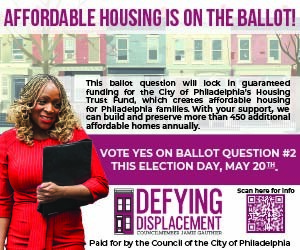 One of the best transportation organization slogans of all time is SEPTA’s simple and self-deprecating: “We’re Getting There.” So Philly.
One of the best transportation organization slogans of all time is SEPTA’s simple and self-deprecating: “We’re Getting There.” So Philly.
Now SEPTA is asking you how they are doing. SEPTA is inviting the public to suggest modifications to current SEPTA routes and requests for additional services. If they make sense, SEPTA may work them into its next annual service plan – for 2016. The service plan will go through a public hearing process before a final vote.
SEPTA received a record number of submissions for its last service plan, perhaps a reflection of the growing interest in public transportation. The recent reintroduction of all-night trains is another indicator.
“We’re seeing a renewed interest in transit, with many residents embracing SEPTA as their primary and preferred choice for travel,” Richard Burnfield, SEPTA’s chief financial officer, said in a press release. “Many riders are showing a great interest in service improvements, and we welcome those suggestions.”
It sounds like complaints about drivers, schedules or the delays in updating the fare payment system won’t go far, but constructive suggestions might.
Send your ideas to serviceplanning@septa.org. You can also mail them to: SEPTA – Service Planning Department, 1234 Market St. 9th Fl., Philadelphia, PA 19107.
They will be accepted through Aug. 31.








July 22nd, 2014 at 6:16 pm
Something I would like to know naturally pertains to trolley service. Namely, how the allocation of trolleys on the routes is determined and how much flexibility there is in the system.
That is to say, if a trolley is designated as “Route 13” does it PERMANENTLY remain on that route for the driver’s full shift or for that full day? It seems that invariably when I’m waiting (especially at 30th st station) tons and tons of Route 10 and Route 11 trolleys come through (sometimes right after one another) and utterly no one gets on. The whole assembled crowd of people is waiting for (usually in order of demand)… the 31, the 13 or the 36.
How often does SEPTA evaluate ridership load and adjust routes? Most of all, I’d love to know more about how the tracks connect up at the far west end (if at all) and if trolleys can change line designation at their terminus should rider load dictate.
I realize that much of what I am asking is premised around some degree of confirmation bias… of COURSE all of the riders who are standing around at the stations are waiting for “other” trolleys to come by… they wouldn’t be waiting there if their needed route had already showed up moments ago.
Still, sometimes it does seem insane to me just how many people are utterly jammed into the trolley cars during rush hour and how many people are clearly desperate to make use of a system.
SEPTA could hardly plead a case for a distressed budget when there are literally more riders than space on the cars at times, can they? I’ve gotten on some trolleys that are so jammed that the drivers don’t even try to ask us to pay, the ride experience is so uncomfortable.
July 22nd, 2014 at 6:17 pm
sorry, that was a typo… in my experience the folk waiting for trolleys at 30th street station (or any of the center city stations) are waiting to board…
the 34
the 13
the 36
… roughly in that order of popularity. But i’d love to hear others’ thoughts on this if i’m wrong. There seem to be some times of the day when EVERYONE around me gets on the 10 line.
July 22nd, 2014 at 6:29 pm
One other thing I’ll mention (and which I did state to SEPTA in an email) that will make me come across sound like some total hipster possibly is something I’ve witnessed out West here the past couple days.
The city of San Francisco has done something fascinating on their trolley network (not their streetcars in the old part of the city, but the MUNI trolleys)… a handful of the cars on their lines appear to be sourced from (or at least done up in the style of) other countries and other periods in history.
Sitting here working out front of my hosts’ building, I have seen the passing of:
1970s Milan Italy streetcar
1940s San Fransisco streetcar
1960s NYC streetcar
1950s (could not see city name) streetcar
They all have a small plaque right by the door where riders board and it’s a beautiful walk through time and other places as they roll past. I shudder to think what budget was involved in sourcing or servicing them like this… but it’s just something I wanted to share.
In a more limited sense, I’d love to know if the old Presidents’ Conference Committee trolley cars that run on the 15 line could ever run on the SouthWest tracks. It’d be really cool to hop on one of them on occasion, i think.
July 22nd, 2014 at 6:31 pm
(for those who are trolley fans and/or train line geeks)…
SEPTA had originally planned to run modern Kawasaki trolleys along the line once service was restored, but a combination of economics and a desire to help revive the Girard Avenue corridor with a more “romantic” vehicle led to the agency restoring the old vehicles for about half the cost of new cars.
SEPTA uses Kawasaki vehicles on the rest of its trolley lines, including the Subway-Surface Green Line linking West Philadelphia with Center City and its 69th Street Terminal with the western suburbs of Media and Sharon Hill via light rail routes 101 and 102.
(from Wikipedia, take with the customary grain of salt)
July 23rd, 2014 at 7:11 am
Deviant Ollam: I was living in SF when they started running that streetcar line out Market Street — brilliant. And though you didn’t mention it, there are PTC trolleys among their rolling stock.
July 23rd, 2014 at 9:31 am
Would this be the right email address to suggest training their drivers to stop blowing the 120 decibel horn all the time as they go through these residential neighborhoods. It’s a bit frustrating that the SEPTA vehicles would be the worst contributors to road rage honking noise.
July 23rd, 2014 at 6:39 pm
The issue of the horn isn’t totally off-the-mark. I personally just have grown to accept the horn as a part of the background noise of the area, but they surely are noticeable.
I’m curious if SEPTA can speak to when and why the horns are used and for what purpose. If it’s safety and alerting other drivers, of course that’s appropriate. However, if they are a sort of “i’m stopping” or “i’m moving to the next stop” then it would be great if there was a bell like on most other trolley systems in other cities.
July 23rd, 2014 at 8:23 pm
The PCC-IIs have to run on the 15-Girard because of the ADA: the 15 was a (wheelchair-accessible) bus for long enough that you can’t legally run non-accessible K-car trolleys on it. Thus why SEPTA sent 17 PCCs to Brookville to have wheelchair lifts hacked into them. Unfortunately, the PCC-IIs are so unreliable that riders and SEPTA both hate them, and the next trolley purchase (possible thanks to Act 89) will probably replace the PCCs firstbefore coming south to the subway-surface routes.
July 24th, 2014 at 2:45 pm
Re: Septa Regional Train Lines. Will you please consider putting handicap entrances and exits on all the cars? It is extremely difficult to step up and down on the high steps for people with disabilities. There are only a few in Montgomery County that have flat platforms to train entrances. Septa is not following the American Disability Act. Please consider this request in your planning
February 13th, 2016 at 3:28 pm
I live in University City and saw an advertisement to send in comment or suggestions to improve any bus, trolley route stops.
My thought is safety- is it possible that there could be safety alert buttons place within reasonable access to riders, especially in the bus/ trolley route stops that are not lit or sheltered, or not in active after dark neighborhoods. University City and other college areas are taken very good care of, but as I travel all over the city there are areas that even though patrolled, they make targets of individuals waiting for transit after dark, Philadelphia police could be alerted to cruise the area again. Bringing the neighborhood watch type mentality to neighborhoods. I think this could only encourage better relationships with neighborhoods and PPD, and feelings of safety within communities which may feel overlooked. This could be a life changing to residents AND transit customers, and not out an outrageous cost to Philadelphia city or transit services that don’t out weigh the benefits, people feeling safe, someone is watching out for them.
Thank you for this opportunity to make suggestions,
Cheryl Timony 322s43rd St, 19104
267-258-0317
Ctimony.profoundartcreations@gmail.com